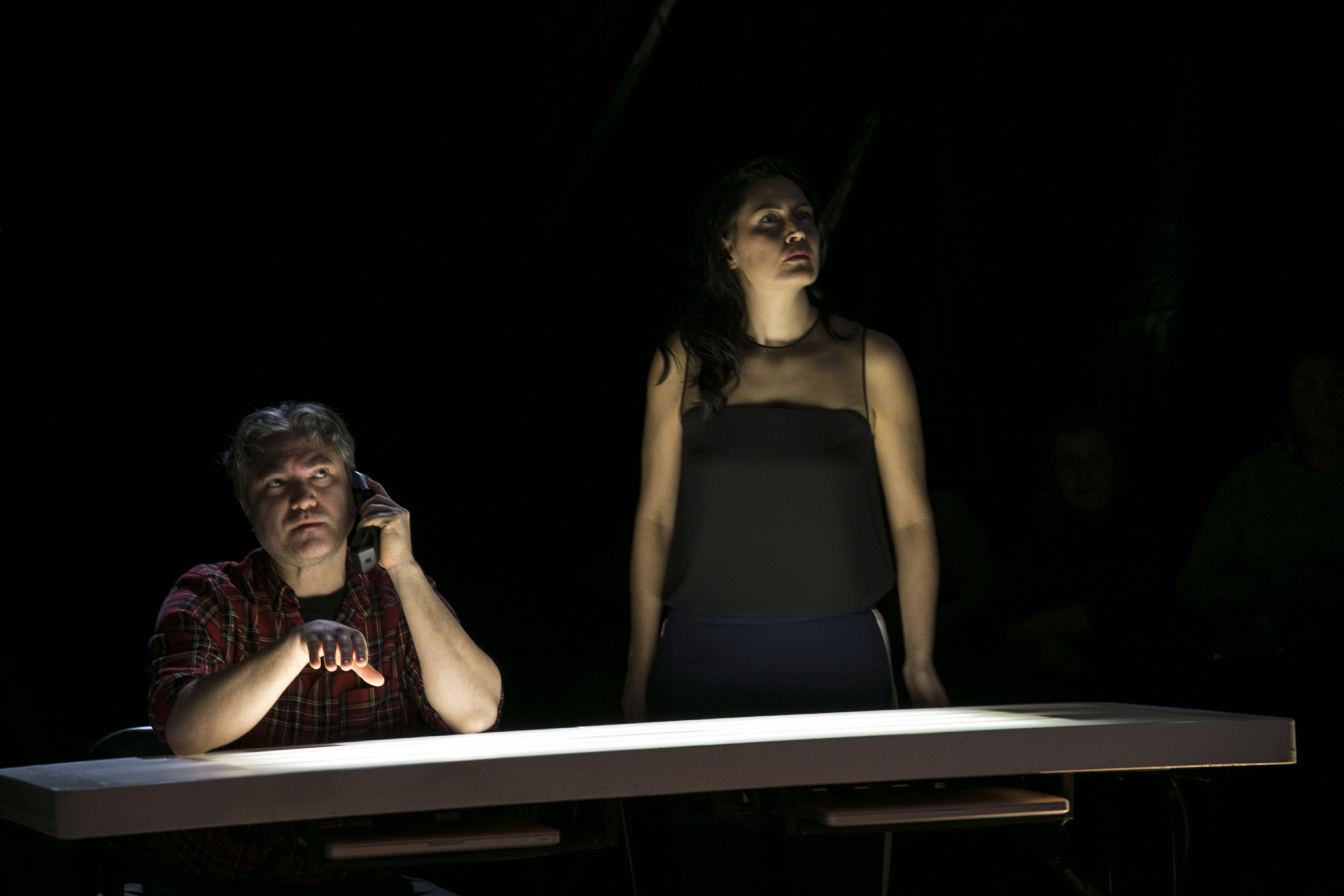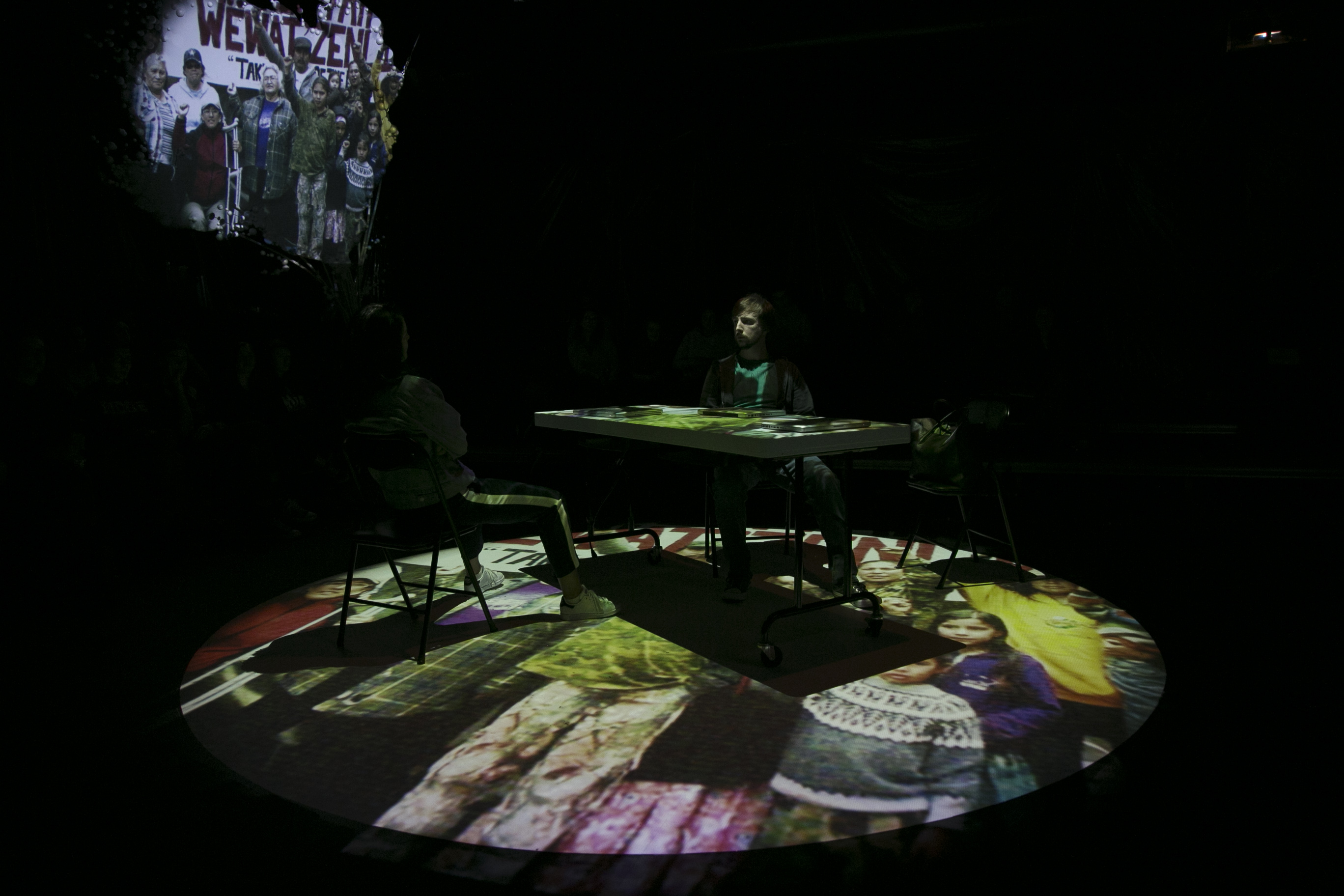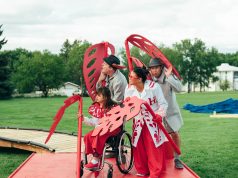
“You’re a coward!” the woman in the back row of the theatre spat at Max Fawcett after the pipeline proponent stated that he wouldn’t wade into the issue of Indigenous land claims; he’d “leave that to the courts”.
Some audience members nodded enthusiastically, others became still as they realized that this was going to get real. I was thrilled. The debates that all too often take place anonymously online, or between politicians or ‘experts’ were now occurring between regular citizens – live – in the small studio at the Gateway Theatre in Richmond BC.
This was the first comment of the night.
This conversation happened during Act Two of The Pipeline Project. Act One is the play written by Quelemia Sparrow, Kevin Loring, and Sebastien Archibald. It’s a part-verbatim, part meta-theatrical exploration of resource extraction, First Nations Land claims, and first world guilt. Act Two is a community dialogue that allows the audience to unpack/process the first act. We call it a ‘Talk Forward’.
Each Talk Forward featured a different guest speaker who had experience relevant to the play. Speakers ranged from Clean Energy BC CEO Paul Kariya, to members of the Unist’ot’en clan from Northern BC, to Kai Nagata (Dogwood Initiative), to Caleb Behn (Eh-Cho Dene and Dunne Za/Cree lawyer and activist). On this particular evening, our speaker was Max Fawcett, a writer and former editor of Alberta Oil. Max is an outspoken supporter of the proposed Kinder Morgan Trans Mountain Pipeline Expansion.
Each speaker took 10 minutes to respond, connecting what they saw in the show to their real-life experience. Then I interviewed them for 5-minutes to jump start a conversation. After that, we widened the circle and engaged the audience in a 20-30 minute facilitated dialogue. Each night ended with the speaker suggesting an action the audience could take, answering the question “but what can I do?”. This was intended to activate the audience rather than leave them feeling defeated by the weight of the issues. Suggestions ranged from “donate to the Pull Together campaign” to “use your head and heart.” Calls to action that were sometimes tangible and sometimes more abstract. The Speaker responses were filmed and posted on Facebook and Twitter where the conversation continued online.
It was an experiment and we were more than a bit nervous. Would people stay for the second act? Would they talk? Would it feel relevant? The answer to all three of those questions was yes. On average, 90% of the audience stayed and the conversation was going on so passionately at the end of the night that it carried on for over a half hour in the lobby.
For the most part, the conversations felt vital. Like the night a young white man who had spent time in prison rejected the idea of White Privilege and his comments sparked a fierce debate with our all-female youth panel. Or when someone asked a very straightforward question like “what’s the NEB?” and another audience member provided the answer. It was clear that many people in the audience were learning this information for the first time. Several nights there were Indigenous audience members who shared their personal experience. I witnessed an older white woman go up to an Indigenous woman of about the same age and thank her for the story she shared about her history with residential schools. Two Canadians living in this country at the same time with vastly different experiences, connecting face to face.
There is immense value in looking into another person’s eyes. There is great power in hearing a live voice and seeing a viewpoint embodied. Those of us who make theatre know this. This is why theatre continues to live on despite hundreds of years of being told it is on the brink of extinction. Because people in a room together is too powerful and too delicious to ever go away.

So now I am left with the question – how do I as a theatre practitioner do a better job of lifting the audience out of darkly lit obscurity? How do I shine a light on them and include them in the blood-pumping experience of real human contact in a theatre space? I think that Talk Forwards are a place to start. And I’m aware that I have only just started. There is much to be discovered about how to encourage uncomfortable conversations and making the theatre a place where debate can occur and not just be an echo chamber.
At the end of the night, after the conversation had shifted from name calling to pointed, informed questions, one of the co-creators Kevin Loring – a member of the Nlaka’pamux nation who is fiercely opposed to resource extraction on unceded territory – said he thought it was very brave of Max to do what he did. He respected Max for his honesty and his ability to stand in a room of people who disagreed with him and state his opinion. That takes guts and is the only way real change can occur. Kevin said he wanted to give Max a shot of whiskey to thank him. Then we stood together in the lobby drinking whiskey, talking about this land, and about what comes next.
See a full list of speakers HERE, and view the speakers’ responses on The Pipeline Project Facebook page HERE.









